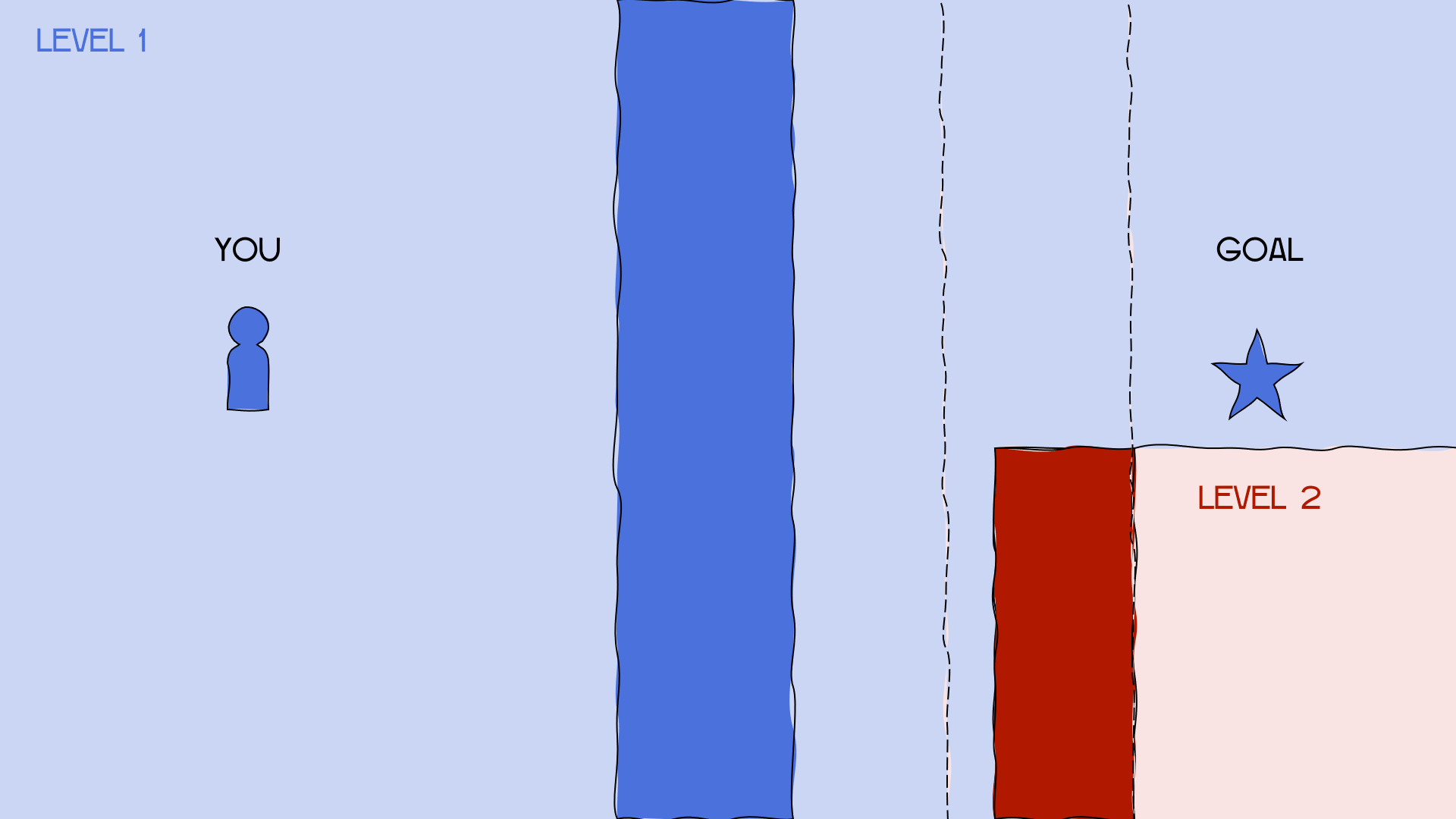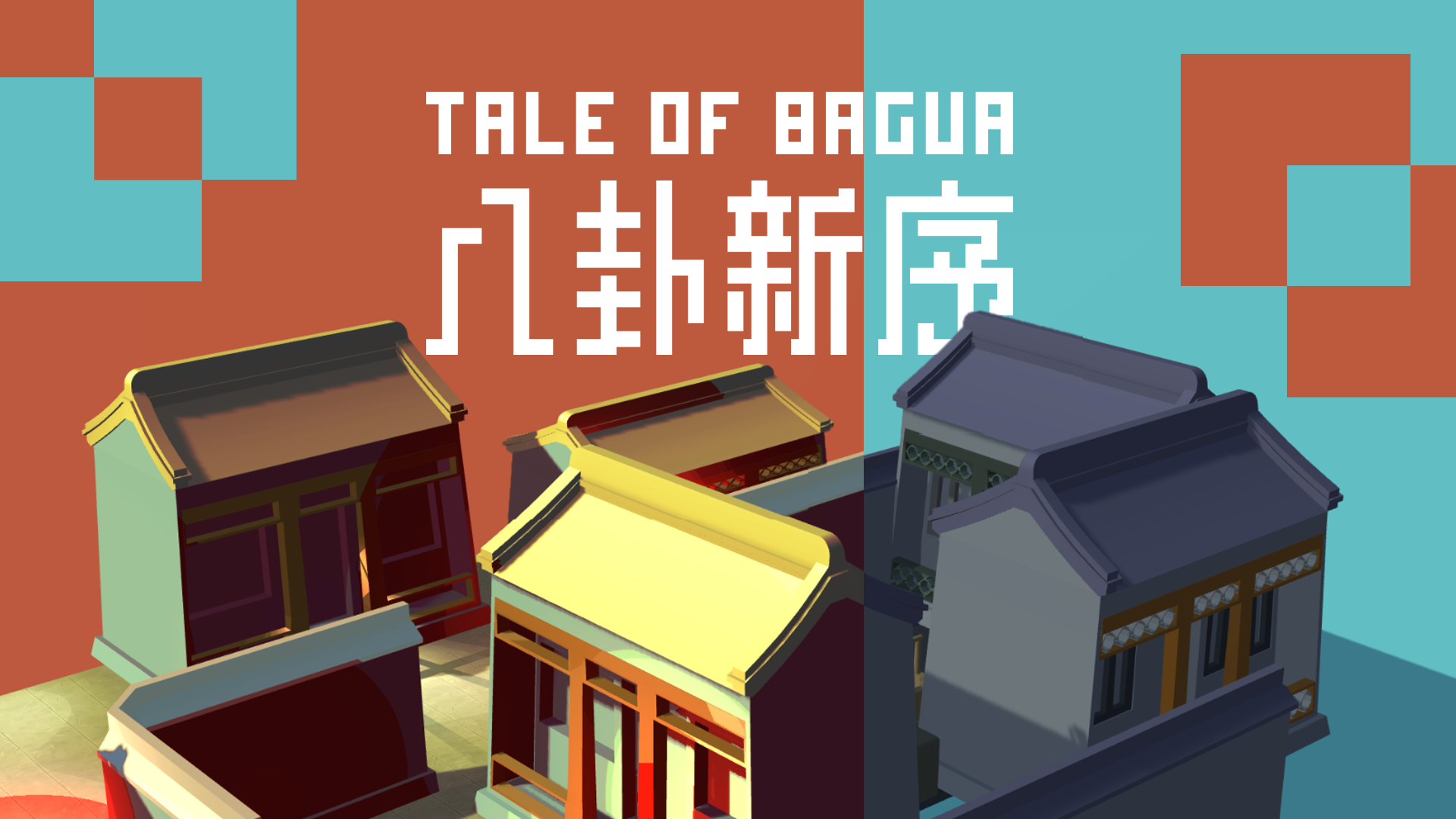Impossible mechanic in 16 hours | Global Game Jam Recap
View the project on nickydu.net.
Introduction
Tale of Bagua is a 4D puzzle game developed by a team of three, in which the player overlays portals to access different times in the past. Portal effects are multiplied in the overlapped area, creating a kaleidoscope of historical events. Its idea was sparked on Global Game Jam 2023 and its demo was designed from scratch in 16 hours.
Seemingly Impossible Mechanic Design: “Portal kaleidoscoping”
The idea is simple. The player moves a window on the screen. The window reveals the view of another world, and the player can walk between the two worlds freely through this window.
If world A has an obstacle, simply switch to world B where that obstacle doesn’t exist, walk to your target position, and switch back to world A.


What’s more, one can overlap these portals, creating a new portal in the overlapped area, containing a new level.

To achieve this mechanic in-game, we need to overcome these problems:
- Visuals: The portals and their overlaps should display different scenes (and lighting) accordingly.
- Colliders: A portal should cut colliders with its edge.
- No-Clips: When switching worlds, one might get no-clipped into a wall and get stuck in there. One might also get squished into a wall when the portal moves.
With a team effort, we managed to achieve the same mechanic with a slightly different technical approach using Unity’s stencil feature. As a Level Designer, here’s the solutions I came up with:
- Visuals - Using one directional light for the daytime levels and baking the nighttime levels individually.
- Colliders - Only one set of colliders is up at one point.
- Logic: If the player is overlapped with X portals, activate the colliders of Level X+1
- Example: The player is standing in 2 portals, meaning they should be on Level 3. Activate the corresponding colliders.
- No-Clips - Making the moving portal “push” and “pull” the player to a place that won’t no-clip.
- Logic: When not activated, the colliders of each level turn into triggers. Make a portal itself a ring-shaped collider.
- To prevent getting stuck in the next level’s collider: If the player touches any trigger of the next level, the ring-shaped colliders on the portals cannot be entered. This will result in the portal pushing the player until they get out of that no-clip hazard.
- The prevent getting stuck in the previous level’s collider: If the player touches a trigger of the previous level, the ring cannot be exited. This will result in the portal pulling the player until they are at a place that won’t no-clip.
- Logic: When not activated, the colliders of each level turn into triggers. Make a portal itself a ring-shaped collider.
Level Design: Making intricated puzzles with 5 overlapping mazes
Now that the core mechanics are done, how to make this “switch world, pass obstacle” trick complex and fun? As a Level Designer, these are the directions I’m going for:
- More switches and deeper switches. To collect the heirloom in each level, a player needs to switch multiple times. The deepest ones go across multiple levels.
- More walking and no sitting-still solution. The player has to explore the entirety of a new level before, on top of switching worlds, in order to get the heirloom.
And these are the solutions I applied:
- 3 shared spaces with neighboring levels. A level should share at least 3 spaces with the previous and following levels. These 2 sets of shares spaces should avoid overlapping.
- No shared space with 4 levels in a row. For example, level 1-4 can’t share the same vacant space.
- Avoid large vacant spaces. Use long alleyways and small spots.
- Each level has a distinct color pallet. The deeper a level is, the simpler and more monotonic its visuals are.

What went well
- Mechanic Design-wise, we fully achieved what we wanted to have in the game.
- Level Design and difficulty-wise, we created intricate puzzles that took our players over 30 minutes to complete. For a 16-hour project, it’s more than enough.
- Our focus on whiteboxing paid us back with an almost bugless prototype.
- The concept and narrative fit extremely well with the Game Jam’s theme “roots”, telling a story of a Chinese kid who uses his family heirloom “Ba Gua Mirror” to travel back in time, searching for his ancestors.
What went wrong
- As a producer, I focused too much on playability and didn’t manage the 3D art tasks effectively enough, leading to many last-minute visual problems.
- As a level designer, I went all in to design the most sophisticated puzzles and didn’t care about making a tutorial. This results in the new players not knowing the basics.
- It’s almost impossible to see anything when the player is at the final level. It’s an actual kaleidoscope with 20+ sections. Only one of them shows level 5, and you need to peek through that tiny hole to find your way.
- The ending of the narrative is rushed and didn’t reveal the plot well enough.
What next
We want to make a whole series of games with this mechanic because of how brilliant and refreshing it is. Here’s what we will do.
- Mechanic Design
- Make the portals easier to control. More UI elements to indicate the layering. Add responsive animations.
- Add a fullscreen option that expands selected portals to cover the whole screen, so that you won’t be peeking through a tiny slit when you’re 5 levels deep.
- Add conversations and other narratively beneficial things to increase story density.
- Add mini puzzles to increase overall variety.
- Level Design
- Playtest multiple times to re-adjust the difficulty curve.
- Add a tutorial level. Make the first chapter easier, at about 15 minutes avg playing time.
- When everything is set, we are ready to make chapter two.
- Visuals
- Bake each level individually.
- Optimize assets and palettes. Make sure every part of a level is equally recognizable on first glance.
- Narratives
- Add more motives to the main character’s actions.
- Explain more about the heirlooms: what is a Ba Gua mirror? How is it related to Ying Yang and Chinese history? Why can it bring us back in time?
Summary
Tale of Bagua is a success for 16 hours of work in a 2-day game jam. We want to push the idea further by finishing other aspects. Our short-term goal: make one interesting, polished, and visually stunning chapter to pitch our game for potential investments.
Tale of Bagua
Travel the dimensions. Overcome puzzles. Go all the way back to where it began.
| Status | In development |
| Authors | Nicky Du, CECIL, Alextianyouwang |
| Genre | Puzzle |
| Tags | Difficult, Experimental, Global Game Jam, Time Travel |
More posts
- DevLog - PreAlpha 1.1.0Oct 04, 2023
- DevLog - PreAlpha 1.0.0Feb 15, 2023
- Devlog - Global Game Jam demoFeb 15, 2023

Leave a comment
Log in with itch.io to leave a comment.